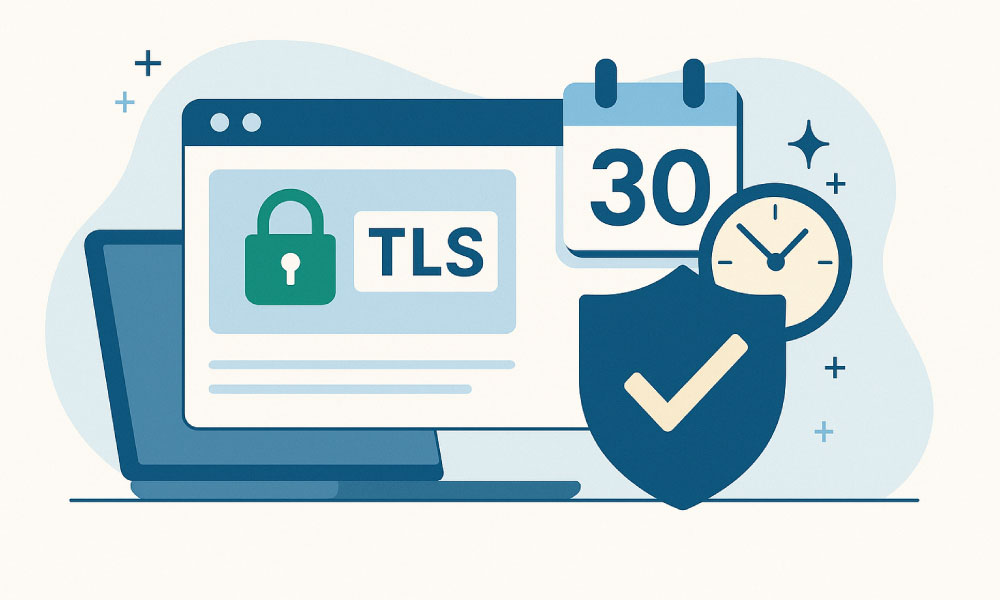Rethinking Certificate Management in an Era of Shorter TLS Lifespans

Digital trust is not just a checkbox—it’s an operational necessity. TLS (Transport Layer Security) certificates underpin this trust, ensuring encrypted, authenticated communication across websites, apps, and networks. But as security standards evolve, so must the way organizations manage these certificates.
By 2029, a significant shift will transform TLS certificate validity, and enterprises that rely on manual or siloed workflows may struggle to keep pace.

The Coming Challenge: Shorter Validity Periods
TLS certificates today can be valid for up to 398 days. However, ongoing efforts by browser providers and Certificate Authorities (CAs) will reduce that lifespan significantly—to just 47 days by 2029.
This shift is being driven by a clear goal: strengthen web security. With shorter certificate cycles, the risk of long-term exposure due to compromised keys or outdated encryption standards is drastically reduced.
Yet for organizations managing hundreds or thousands of certificates, this new standard also means a major uptick in renewal frequency, system checks, and deployment logistics.

Why Traditional Workflows Are No Longer Enough
A reduced validity period will demand a renewal every six to seven weeks per TLS certificate. For IT and DevOps teams already stretched thin, this creates an environment ripe for failure—missed expirations, inconsistent renewals, or misconfigurations that cause downtime.
Manual processes like spreadsheets or static tracking tools simply won’t scale. The stakes are higher than ever:
- Certificate expiration can lead to service disruptions
- Poorly managed certificates increase compliance risks
- Manual renewals divert resources and invite human error
Enterprises need smarter, more agile systems to keep digital trust intact without compromising speed or efficiency.

A Smarter Approach: Automating the Certificate Lifecycle
The best way forward? Automate, centralize, and enforce policies around certificate usage.
DigiCert Trust Lifecycle Manager (TLM), offered by Reg.Asia, provides a complete platform to manage the certificate lifecycle—from issuance to expiration—across cloud, on-premise, and hybrid environments.
What Trust Lifecycle Manager Offers:
- Automated certificate handling to eliminate the risks of manual processes
- Centralized visibility over all certificate types—TLS, code signing, device identities
- Policy-based control for consistency and compliance
- Integration with DevOps tools to support continuous delivery workflows
- Full audit logs and analytics for operational and regulatory insight
TLM equips teams with the tools to stay agile, secure, and ready for high-frequency certificate renewals.

Proactive Preparation Starts Now
Though 2029 feels distant, preparing your infrastructure for automated certificate lifecycle management takes time. Complex organizations need to assess current tools, map dependencies, and align stakeholders.
Here’s how to start:
- Audit your existing certificates: Know what’s in use and when they expire.
- Identify manual bottlenecks: Look for where human intervention is frequent.
- Evaluate automation readiness: Do your tools and teams support continuous certificate operations?
- Plan a phased rollout: Begin with a subset of systems and expand
Forward-looking organizations that act now will avoid the last-minute scramble when industry standards formally change.

Final Thoughts
The reduced TLS certificate lifespan is more than a compliance update—it’s a call to rethink how your organization handles digital trust. With Reg.Asia and DigiCert Trust Lifecycle Manager, you gain a scalable, secure way to adapt and thrive in this changing landscape.
Explore how Reg.Asia can help modernize your certificate infrastructure:
Learn More = https://www.reg.asia/trust-lifecycle-manager/
